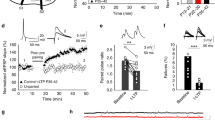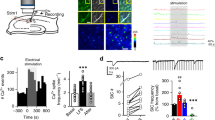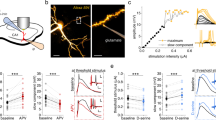Abstract
Long-term depression (LTD) between cortical layer 4 spiny stellate cells and layer 2/3 pyramidal cells requires the activation of NMDA receptors (NMDARs). In young rodents, this form of LTD has been repeatedly reported to require presynaptic NMDARs for its induction. Here we show that at this synapse in the somatosensory cortex of 2- to 3-week-old rats and mice, postsynaptic, not presynaptic NMDARs are required for LTD induction. First, we find no evidence for functional NMDARs in L4 neuron axons using two-photon laser scanning microscopy and two-photon glutamate uncaging. Second, we find that genetic deletion of postsynaptic, but not presynaptic NMDARs prevents LTD induction. Finally, the pharmacology of the NMDAR requirement is consistent with a nonionic signaling mechanism.
This is a preview of subscription content, access via your institution
Access options
Subscribe to this journal
Receive 12 print issues and online access
$209.00 per year
only $17.42 per issue
Buy this article
- Purchase on Springer Link
- Instant access to full article PDF
Prices may be subject to local taxes which are calculated during checkout






Similar content being viewed by others
References
Bouvier, G., Bidoret, C., Casado, M. & Paoletti, P. Presynaptic NMDA receptors: roles and rules. Neuroscience 311, 322–340 (2015).
Glitsch, M. & Marty, A. Presynaptic effects of NMDA in cerebellar Purkinje cells and interneurons. J. Neurosci. 19, 511–519 (1999).
Corlew, R., Wang, Y., Ghermazien, H., Erisir, A. & Philpot, B.D. Developmental switch in the contribution of presynaptic and postsynaptic NMDA receptors to long-term depression. J. Neurosci. 27, 9835–9845 (2007).
Yu, Y., Maureira, C., Liu, X. & McCormick, D. P/Q and N channels control baseline and spike-triggered calcium levels in neocortical axons and synaptic boutons. J. Neurosci. 30, 11858–11869 (2010).
Christie, J.M., Chiu, D.N. & Jahr, C.E. Ca2+-dependent enhancement of release by subthreshold somatic depolarization. Nat. Neurosci. 14, 62–68 (2011).
Christie, J.M. & Jahr, C.E. Dendritic NMDA receptors activate axonal calcium channels. Neuron 60, 298–307 (2008).
Pugh, J.R. & Jahr, C.E. NMDA receptor agonists fail to alter release from cerebellar basket cells. J. Neurosci. 31, 16550–16555 (2011).
McGuinness, L. et al. Presynaptic NMDARs in the hippocampus facilitate transmitter release at theta frequency. Neuron 68, 1109–1127 (2010).
Rossi, B. et al. Current and calcium responses to local activation of axonal NMDA receptors in developing cerebellar molecular layer interneurons. PLoS One 7, e39983 (2012).
Buchanan, K.A. et al. Target-specific expression of presynaptic NMDA receptors in neocortical microcircuits. Neuron 75, 451–466 (2012).
Christie, J.M. & Jahr, C.E. Selective expression of ligand-gated ion channels in L5 pyramidal cell axons. J. Neurosci. 29, 11441–11450 (2009).
Bender, V.A., Bender, K.J., Brasier, D.J. & Feldman, D.E. Two coincidence detectors for spike timing-dependent plasticity in somatosensory cortex. J. Neurosci. 26, 4166–4177 (2006).
Nevian, T. & Sakmann, B. Spine Ca2+ signaling in spike-timing-dependent plasticity. J. Neurosci. 26, 11001–11013 (2006).
Banerjee, A. et al. Double dissociation of spike timing-dependent potentiation and depression by subunit-preferring NMDA receptor antagonists in mouse barrel cortex. Cereb. Cortex 19, 2959–2969 (2009).
Larsen, R.S. et al. Synapse-specific control of experience-dependent plasticity by presynaptic NMDA receptors. Neuron 83, 879–893 (2014).
Feldman, D.E. Timing-based LTP and LTD at vertical inputs to layer II/III pyramidal cells in rat barrel cortex. Neuron 27, 45–56 (2000).
Rodríguez-Moreno, A. & Paulsen, O. Spike timing-dependent long-term depression requires presynaptic NMDA receptors. Nat. Neurosci. 11, 744–745 (2008).
Rodríguez-Moreno, A. et al. Presynaptic induction and expression of timing-dependent long-term depression demonstrated by compartment-specific photorelease of a use-dependent NMDA receptor antagonist. J. Neurosci. 31, 8564–8569 (2011).
Nabavi, S. et al. Metabotropic NMDA receptor function is required for NMDA receptor-dependent long-term depression. Proc. Natl. Acad. Sci. USA 110, 4027–4032 (2013).
Stein, I.S., Gray, J.A. & Zito, K. Non-ionotropic NMDA receptor signaling drives activity-induced dendritic spine shrinkage. J. Neurosci. 35, 12303–12308 (2015).
Bloodgood, B.L. & Sabatini, B.L. Nonlinear regulation of unitary synaptic signals by CaV(2.3) voltage-sensitive calcium channels located in dendritic spines. Neuron 53, 249–260 (2007).
Nimchinsky, E.A., Yasuda, R., Oertner, T.G. & Svoboda, K. The number of glutamate receptors opened by synaptic stimulation in single hippocampal spines. J. Neurosci. 24, 2054–2064 (2004).
Sabatini, B.L., Oertner, T.G. & Svoboda, K. The life cycle of Ca2+ ions in dendritic spines. Neuron 33, 439–452 (2002).
Sabatini, B.L. & Svoboda, K. Analysis of calcium channels in single spines using optical fluctuation analysis. Nature 408, 589–593 (2000).
McDonough, S.I., Swartz, K.J., Mintz, I.M., Boland, L.M. & Bean, B.P. Inhibition of calcium channels in rat central and peripheral neurons by omega-conotoxin MVIIC. J. Neurosci. 16, 2612–2623 (1996).
Sheng, J. et al. Calcium-channel number critically influences synaptic strength and plasticity at the active zone. Nat. Neurosci. 15, 998–1006 (2012).
Borst, J.G. & Sakmann, B. Calcium influx and transmitter release in a fast CNS synapse. Nature 383, 431–434 (1996).
Jahr, C.E. & Stevens, C.F. Calcium permeability of the N-methyl-D-aspartate receptor channel in hippocampal neurons in culture. Proc. Natl. Acad. Sci. USA 90, 11573–11577 (1993).
Burnashev, N., Zhou, Z., Neher, E. & Sakmann, B. Fractional calcium currents through recombinant GluR channels of the NMDA, AMPA and kainate receptor subtypes. J. Physiol. (Lond.) 485, 403–418 (1995).
Lester, R.A., Clements, J.D., Westbrook, G.L. & Jahr, C.E. Channel kinetics determine the time course of NMDA receptor-mediated synaptic currents. Nature 346, 565–567 (1990).
Adesnik, H., Li, G., During, M.J., Pleasure, S.J. & Nicoll, R.A. NMDA receptors inhibit synapse unsilencing during brain development. Proc. Natl. Acad. Sci. USA 105, 5597–5602 (2008).
Fukaya, M., Kato, A., Lovett, C., Tonegawa, S. & Watanabe, M. Retention of NMDA receptor NR2 subunits in the lumen of endoplasmic reticulum in targeted NR1 knockout mice. Proc. Natl. Acad. Sci. USA 100, 4855–4860 (2003).
Tsien, J.Z., Huerta, P.T. & Tonegawa, S. The essential role of hippocampal CA1 NMDA receptor-dependent synaptic plasticity in spatial memory. Cell 87, 1327–1338 (1996).
Madisen, L. et al. A toolbox of Cre-dependent optogenetic transgenic mice for light-induced activation and silencing. Nat. Neurosci. 15, 793–802 (2012).
Casado, M., Isope, P. & Ascher, P. Involvement of presynaptic N-methyl-d-aspartate receptors in cerebellar long-term depression. Neuron 33, 123–130 (2002).
Park, H., Popescu, A. & Poo, M.M. Essential role of presynaptic NMDA receptors in activity-dependent BDNF secretion and corticostriatal LTP. Neuron 84, 1009–1022 (2014).
Larsen, R.S. et al. NR3A-containing NMDARs promote neurotransmitter release and spike timing-dependent plasticity. Nat. Neurosci. 14, 338–344 (2011).
Sasaki, Y.F. et al. Characterization and comparison of the NR3A subunit of the NMDA receptor in recombinant systems and primary cortical neurons. J. Neurophysiol. 87, 2052–2063 (2002).
Kunz, P.A., Roberts, A.C. & Philpot, B.D. Presynaptic NMDA receptor mechanisms for enhancing spontaneous neurotransmitter release. J. Neurosci. 33, 7762–7769 (2013).
Fiszman, M.L. et al. NMDA receptors increase the size of GABAergic terminals and enhance GABA release. J. Neurosci. 25, 2024–2031 (2005).
Wang, P.Y., Petralia, R.S., Wang, Y.X., Wenthold, R.J. & Brenowitz, S.D. Functional NMDA receptors at axonal growth cones of young hippocampal neurons. J. Neurosci. 31, 9289–9297 (2011).
Clark, B.A. & Cull-Candy, S.G. Activity-dependent recruitment of extrasynaptic NMDA receptor activation at an AMPA receptor-only synapse. J. Neurosci. 22, 4428–4436 (2002).
Vissel, B., Krupp, J.J., Heinemann, S.F. & Westbrook, G.L. A use-dependent tyrosine dephosphorylation of NMDA receptors is independent of ion flux. Nat. Neurosci. 4, 587–596 (2001).
Krapivinsky, G. et al. The NMDA receptor is coupled to the ERK pathway by a direct interaction between NR2B and RasGRF1. Neuron 40, 775–784 (2003).
Weilinger, N.L. et al. Metabotropic NMDA receptor signaling couples Src family kinases to pannexin-1 during excitotoxicity. Nat. Neurosci. 19, 432–442 (2016).
Aow, J., Dore, K. & Malinow, R. Conformational signaling required for synaptic plasticity by the NMDA receptor complex. Proc. Natl. Acad. Sci. USA 112, 14711–14716 (2015).
Min, R. & Nevian, T. Astrocyte signaling controls spike timing-dependent depression at neocortical synapses. Nat. Neurosci. 15, 746–753 (2012).
Rothman, S. Noncompetitive N-methyl-d-aspartate antagonists affect multiple ionic currents. J. Pharmacol. Exp. Ther. 246, 137–142 (1988).
Agmon, A. & Connors, B.W. Thalamocortical responses of mouse somatosensory (barrel) cortex in vitro. Neuroscience 41, 365–379 (1991).
Pologruto, T.A., Sabatini, B.L. & Svoboda, K. ScanImage: flexible software for operating laser scanning microscopes. Biomed. Eng. Online 2, 13 (2003).
Acknowledgements
We thank D. Chiu and W. Sun for discussions and comments on the manuscript. This work was supported by US National Institutes of Health grant NS066037 (C.E.J.).
Author information
Authors and Affiliations
Contributions
B.C.C. and C.E.J. designed the experiments and wrote the manuscript. B.C.C. conducted and analyzed the experiments.
Corresponding author
Ethics declarations
Competing interests
The authors declare no competing financial interests.
Supplementary information
Rights and permissions
About this article
Cite this article
Carter, B., Jahr, C. Postsynaptic, not presynaptic NMDA receptors are required for spike-timing-dependent LTD induction. Nat Neurosci 19, 1218–1224 (2016). https://doi.org/10.1038/nn.4343
Received:
Accepted:
Published:
Issue Date:
DOI: https://doi.org/10.1038/nn.4343
This article is cited by
-
The Role or NMDA Receptors in Epileptogenesis
Neuroscience and Behavioral Physiology (2021)



